Top 15 Texas Shrubs for Your Yard
Looking for a new shrub or bush to add to your Texas yard? You’ve come to the right place! Start by downloading my FREE Native Texas Shrubs PDF. You can take this handy one-pager with you to the plant nursery.
Nurseries are filled with shrubs from other parts of the world, but I want to encourage you to go native instead! Native Texas shrubs can add interest to your landscaping while providing food for pollinators, birds, and other wildlife.
These 15 shrubs are some of the best that Texas has to offer! Most of these are very low maintenance and tolerate drought conditions like champs. They would make a great addition to your yard.
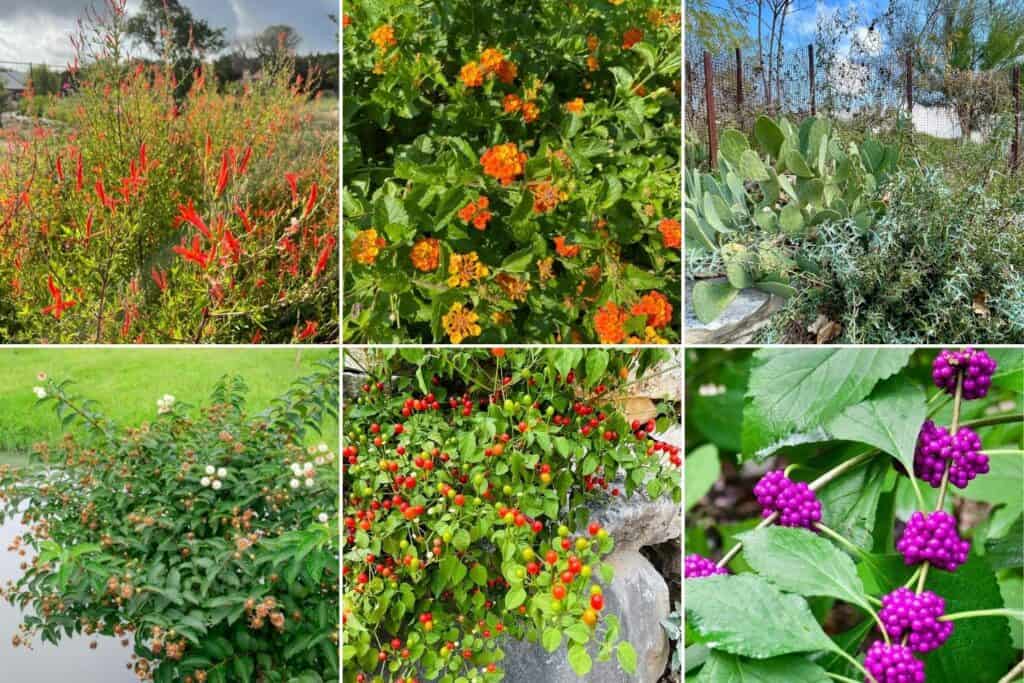
You may be surprised to learn that many of the shrubs and bushes found in Texas landscapes are exotic plants from Asia and Africa.
Common landscaping plants from other parts of the world include Nandina, Crape Myrtles, Ligustrum, Chaste Tree, Japanese Boxwood, Indian Hawthorn and more. While these evergreen plants may look nice, they aren’t doing much for our local ecosystems.
Why It Is Important to Grow Native Plants
If you add any new plant to your yard, make it a native! Native plants are the foundation of a healthy ecosystem. These plants have evolved in your local area, while non-native plants were introduced from other countries. Native plants:
- Are important food source to plant-eating insects and wildlife
- Serve as host plants to butterflies and moths
- Require less water and maintenance
- Support more species than non-native plants
If you are new to native plants be sure to read the Top 6 Benefits of Native Plants in Your Yard. The majority of our yards are currently filled with non-native plants so there are lots of opportunities to swap in some natives and help the environment!
Here are some of the best shrubs you can add to your yard. I’ve included the scientific name in parentheses. Write this down before you go to the nursery to ensure you’re getting the right plant.
Top 15 Native Texas Shrubs
1. Cenizo (Leucophyllum frutescens)
Also known as Texas Sage, this plant happens to be the Official State Native Shrub of Texas! This is a great evergreen option for your yard. It has silvery foliage and is covered with purple blooms after a rain. It is also fairly deer resistant.
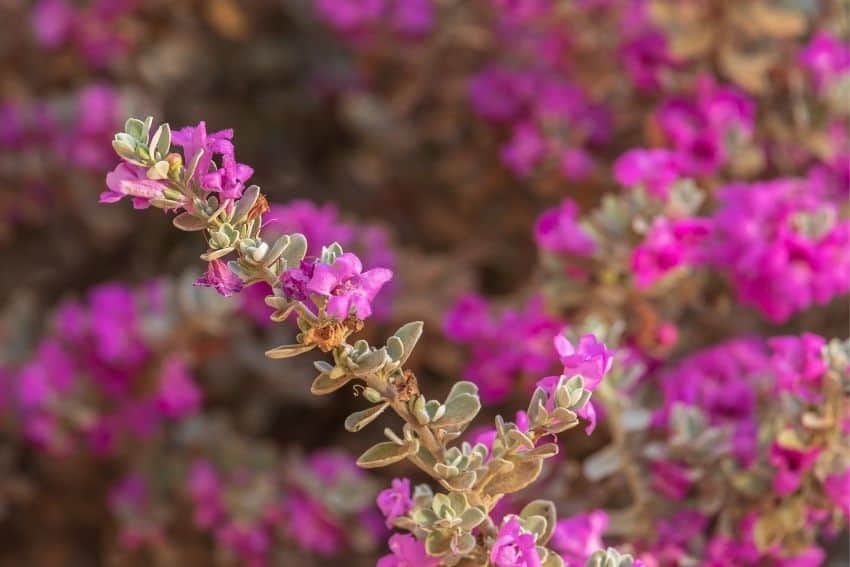
2. Turk’s Cap (Malvaviscus arboreus var. drummondii)
This pretty native shade plant is one of the few that blooms well in part shade and even full shade. Its tubular red flowers will attract hummingbirds to your yard.
This is a common plant to find at most nurseries in Texas. It requires little maintenance but will need to be cut back to the ground in late winter.
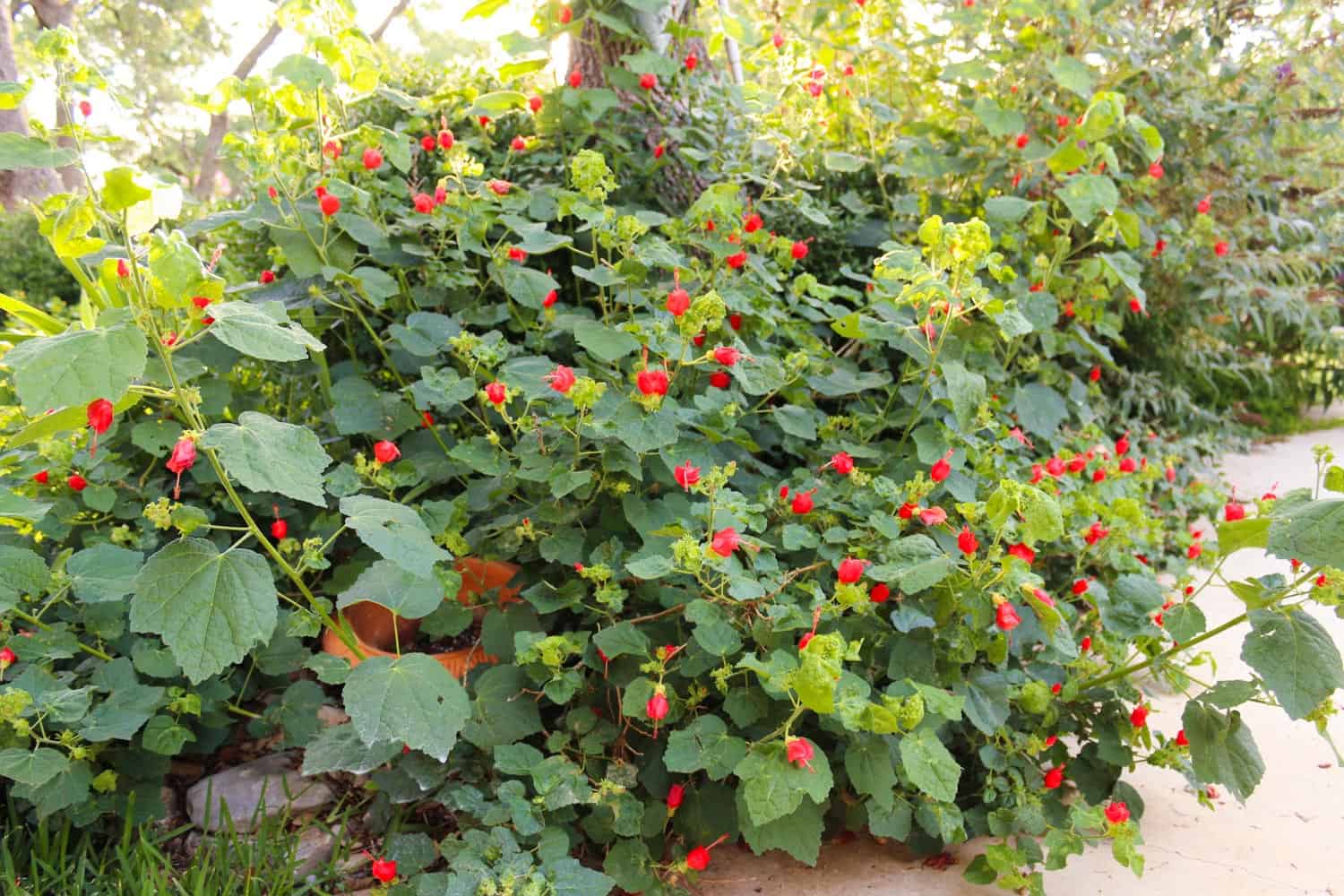
3. Agarita
This shrub with unique prickly foliage will be a standout in your garden. In addition to its evergreen silvery sharp spines, it is covered with yellow flowers in the spring that attract bees and red berries in the summer that are enjoyed by birds.

4. Yaupon Holly (Ilex vomitoria)
Yaupon Hollys can be found in yards across Texas. They can withstand a variety of sun and soil conditions. Female plants have pretty red berries in winter that are enjoyed by birds.
Dwarf Yaupon Holly makes for a compact evergreen shrub or a low hedge when planted in a row.
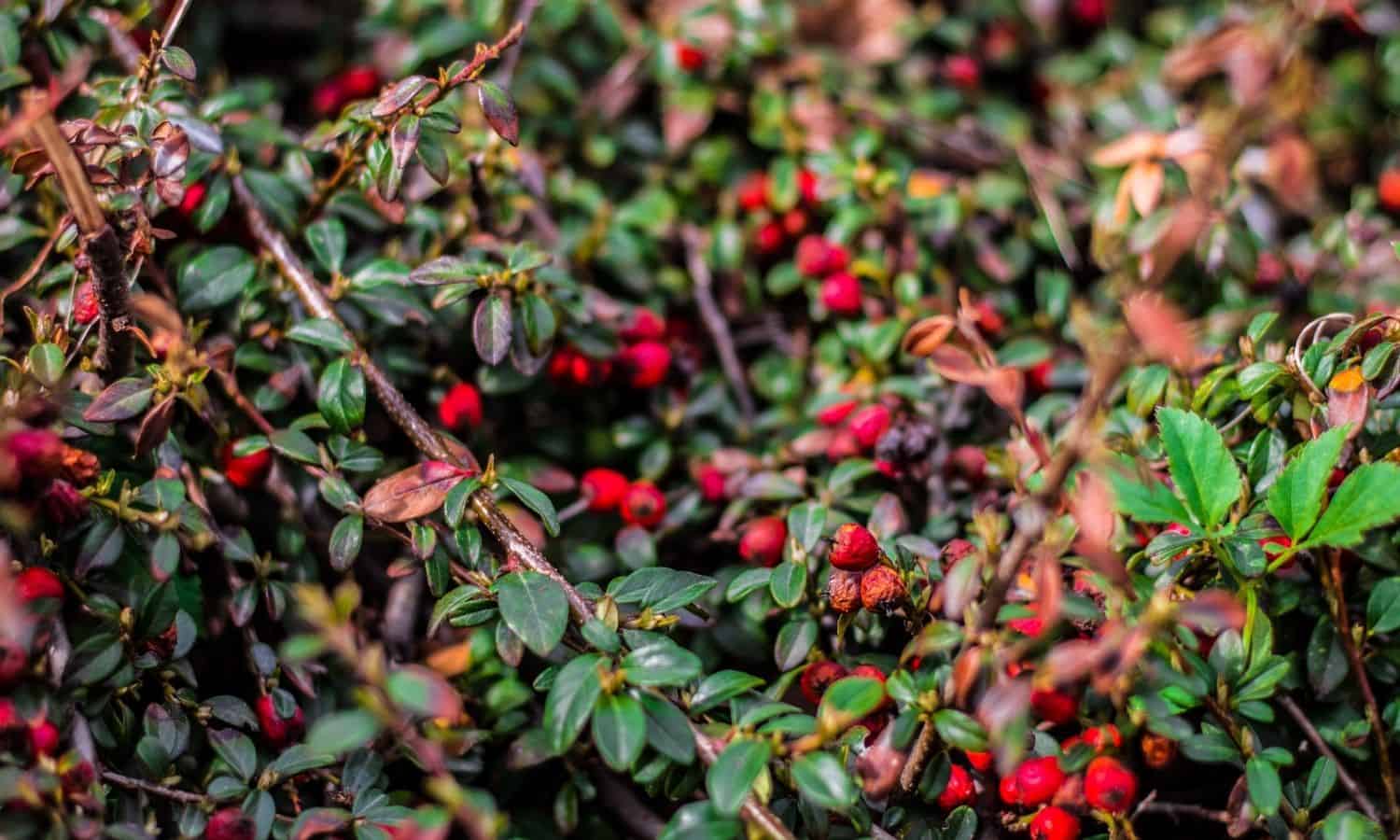
5. American Beautyberry (Callicarpa americana)
This is one of my favorite native shrubs due to its gorgeous purple berries in the fall. They add a bright pop of color to your yard when other plants are winding down for the season.
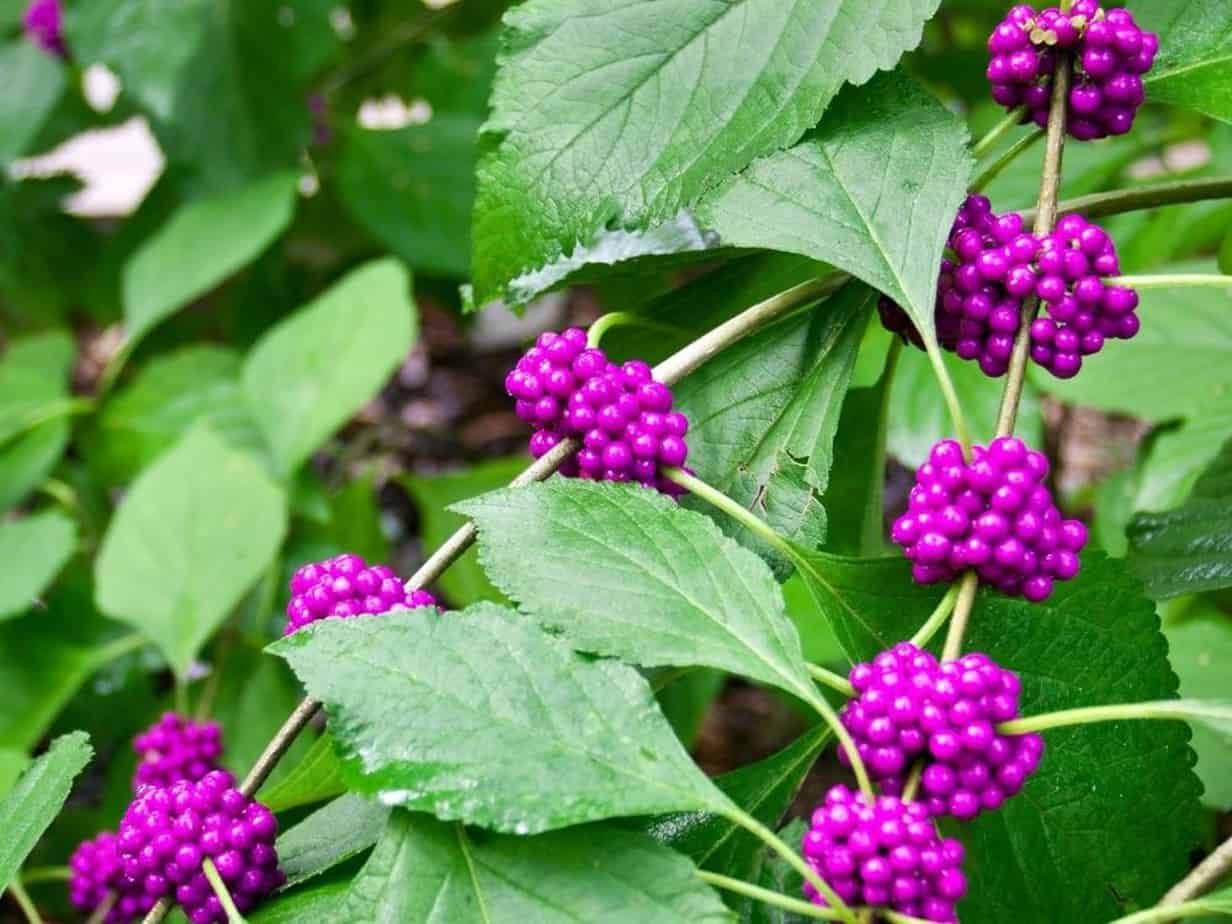
6. Buttonbush (Cephalanthus occidentalis)
Have a large space to fill? Try a Buttonbush. This multi-trunked shrub can grow 6-9 feet tall and wide.
It is covered in fragrant white button-shaped flowers starting in early summer. These blooms will be a bustle of pollinator activity.
In the wild you can find it growing along creek banks so it prefers moist soils. You won’t find many of these in the urban landscape, but there needs to be more of them in our yards!
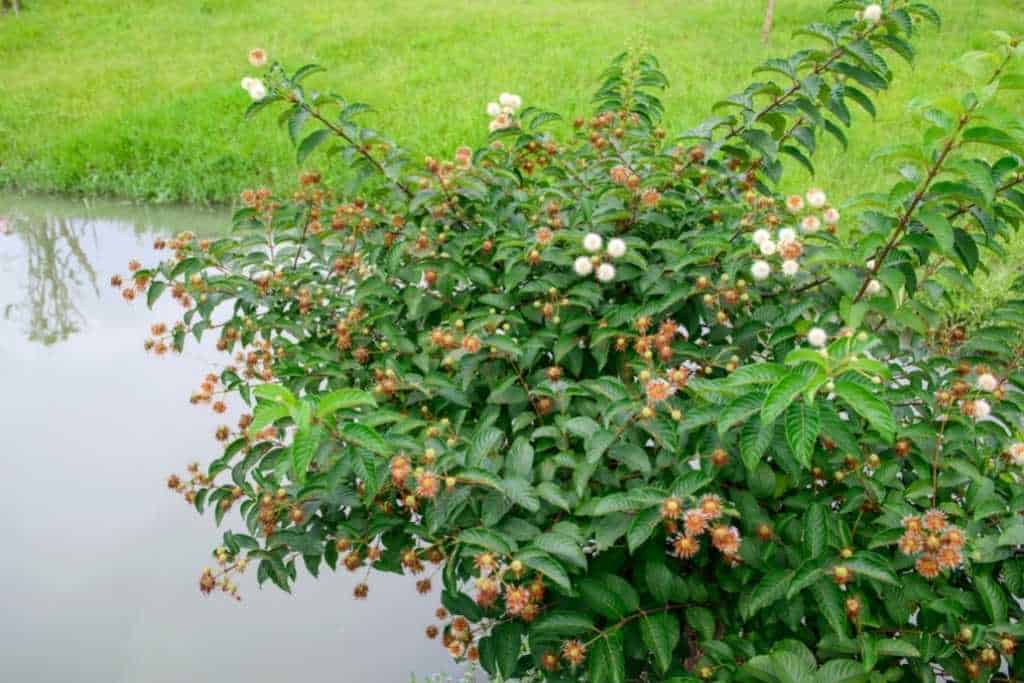
7. Flame Acanthus (Anisacanthus quadrifidus var. wrightii)
Flame Acanthus is a deciduous shrub native to the Texas Hill Country. The bright red flowers on this deciduous shrub are loved by both butterflies and hummingbirds.
These tough plants are not picky about soil type, need little water, and can handle hot temps!
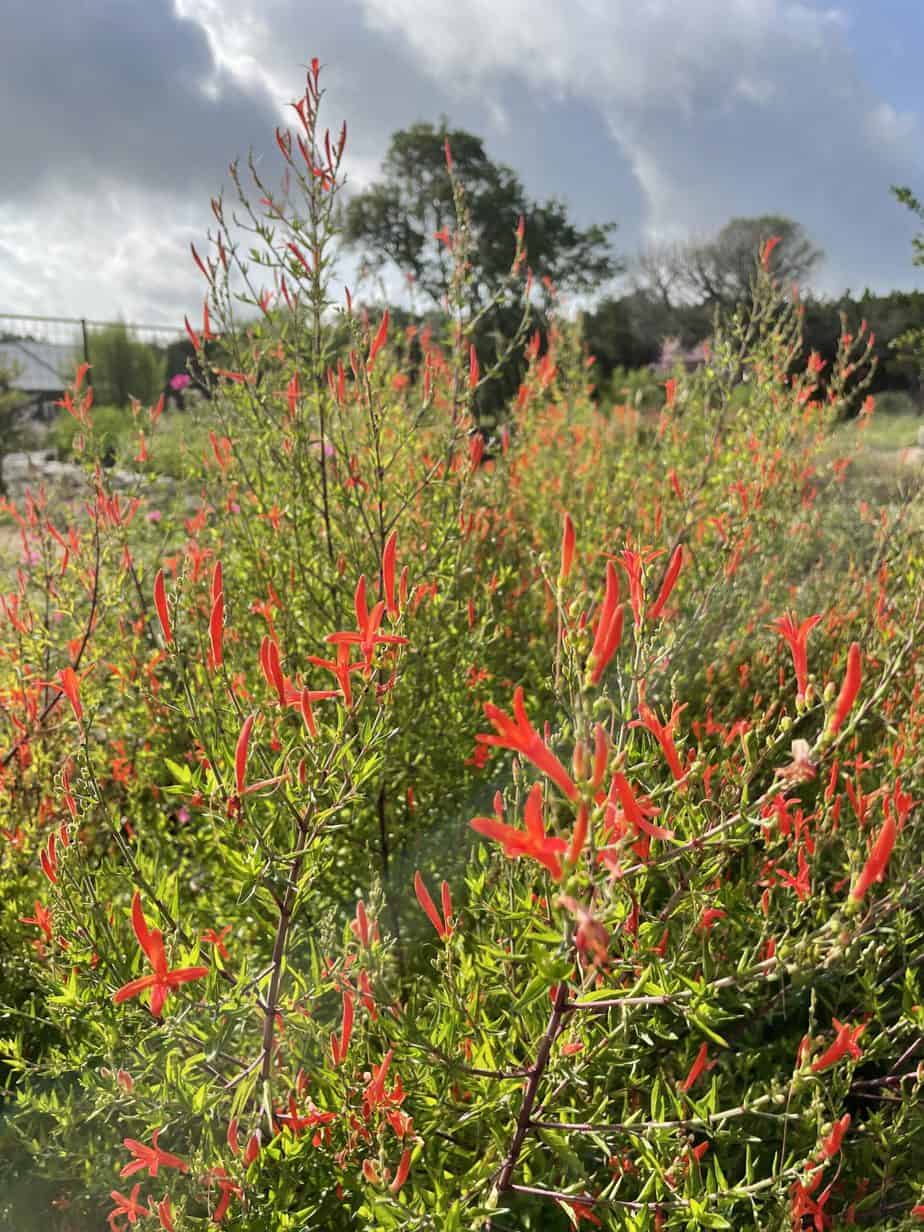
8. White Mistflower (Ageratina havanensis)
White Mistflower goes by other common names including Shrubby Boneset. It is a rounded shrub that grows 2-6 ft tall. Starting in early fall it is covered in white flowers. This plant provides nectar at the best time for migrating Monarchs!
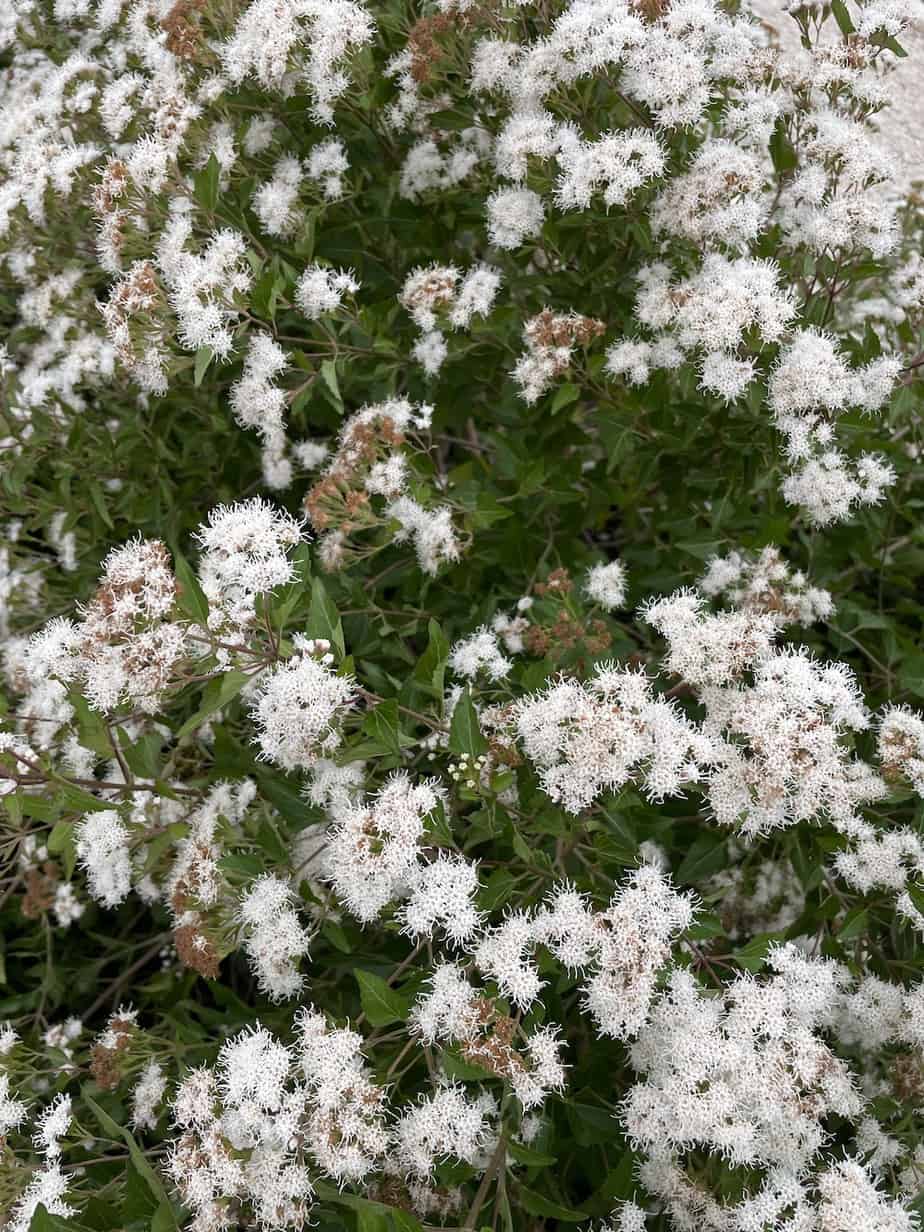
9. Prickly Pear (Opuntia species)
While not technically a shrub, this cool cactus deserves a mention! There are different Prickly Pear species native to Texas, so find one native to your local area. This evergreen plant can add some great structural interest to your garden. It looks particularly nice in the fall and winter paired with native ornamental grasses.
According to the National Wildlife Federation, the Prickly Pear species are host plants for 27 different butterflies and moths.
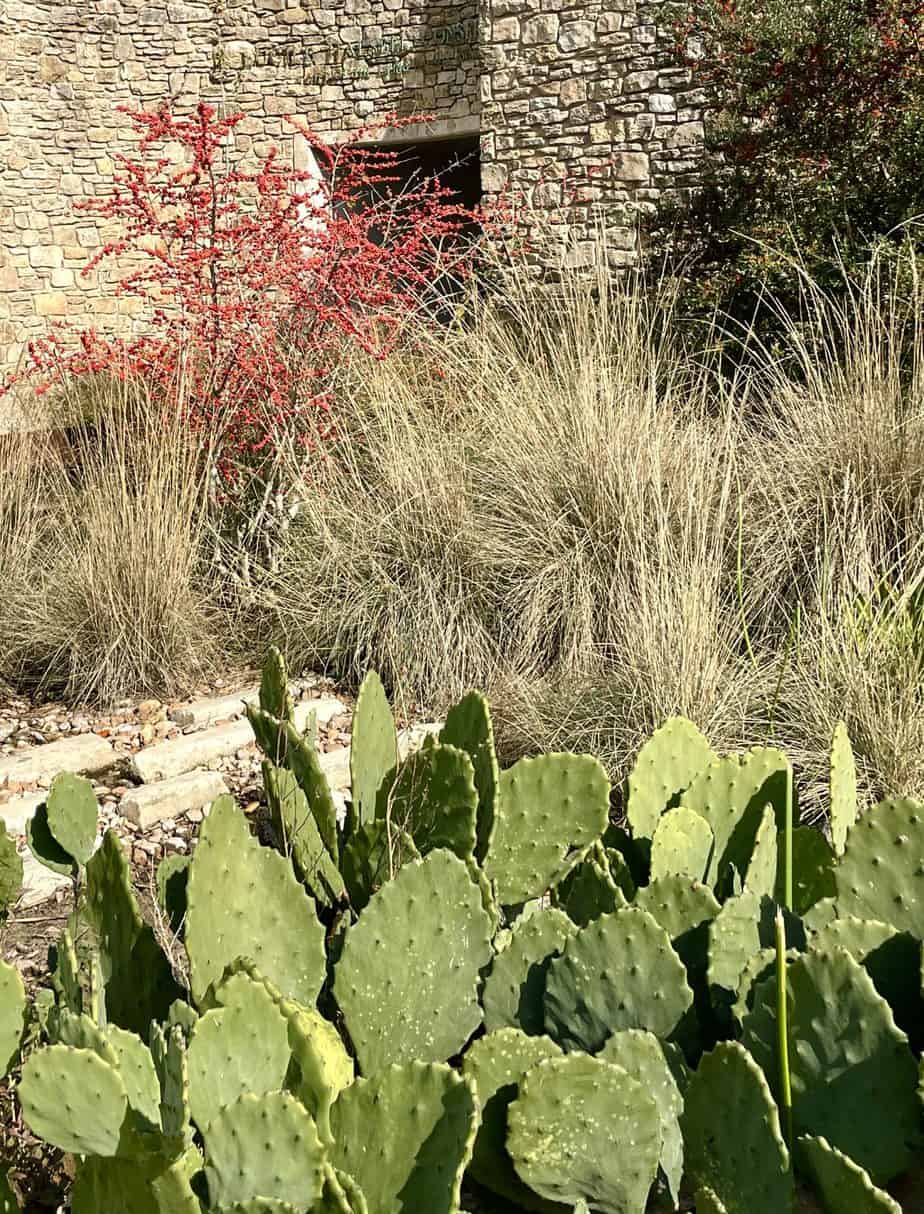
10. Rock Rose (Pavonia lasiopetala)
If you are looking for medium shrubs, try Rock Rose. It starts blooming in late spring and flowers until fall.
Rock Rose is a short lived shrub that grows well for 3-4 years before dying. However it reseeds easily and will put off baby plants to replace the original. It adds a pretty pop of pink to your yard!
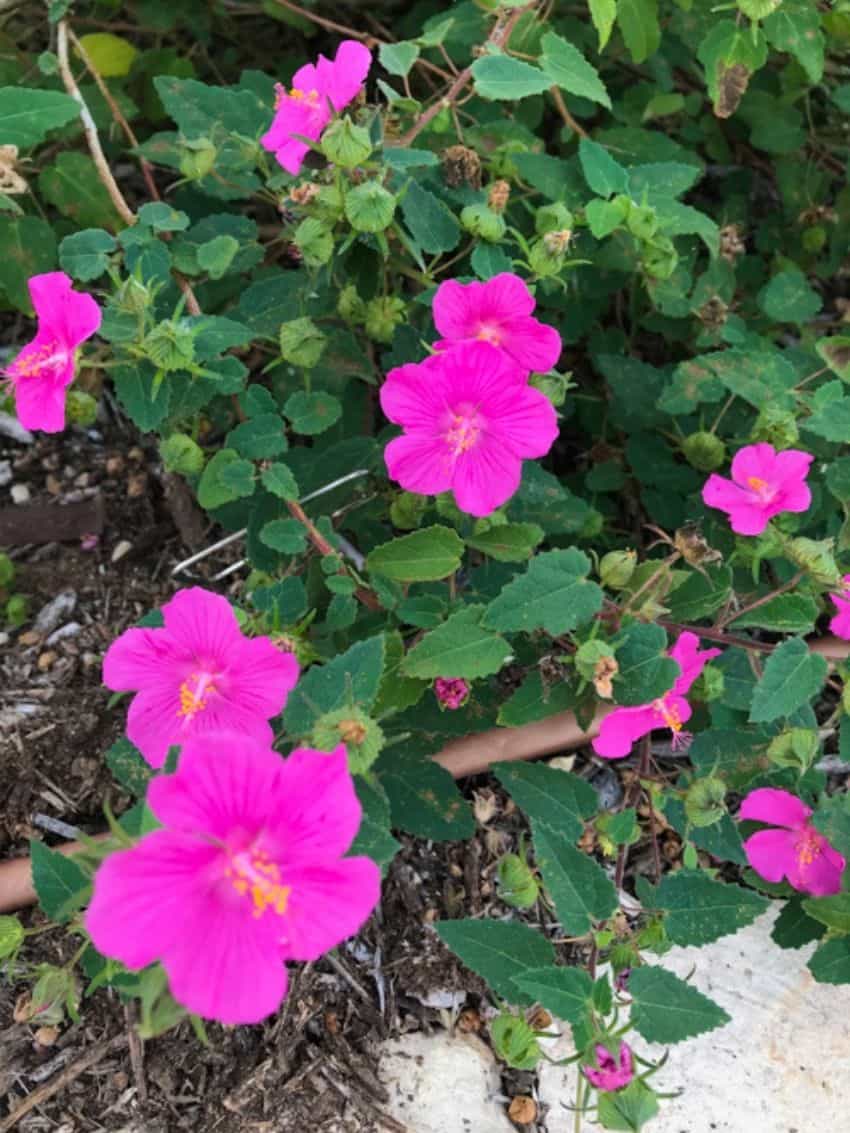
11. Esperanza (Tecoma stans)
This is a popular Texas native shrub that you have likely seen in yards. You should also be able to find it easily at most nurseries. It is a big time bloomer in the heat of the summer, with clusters of fragrant yellow flowers April to November.
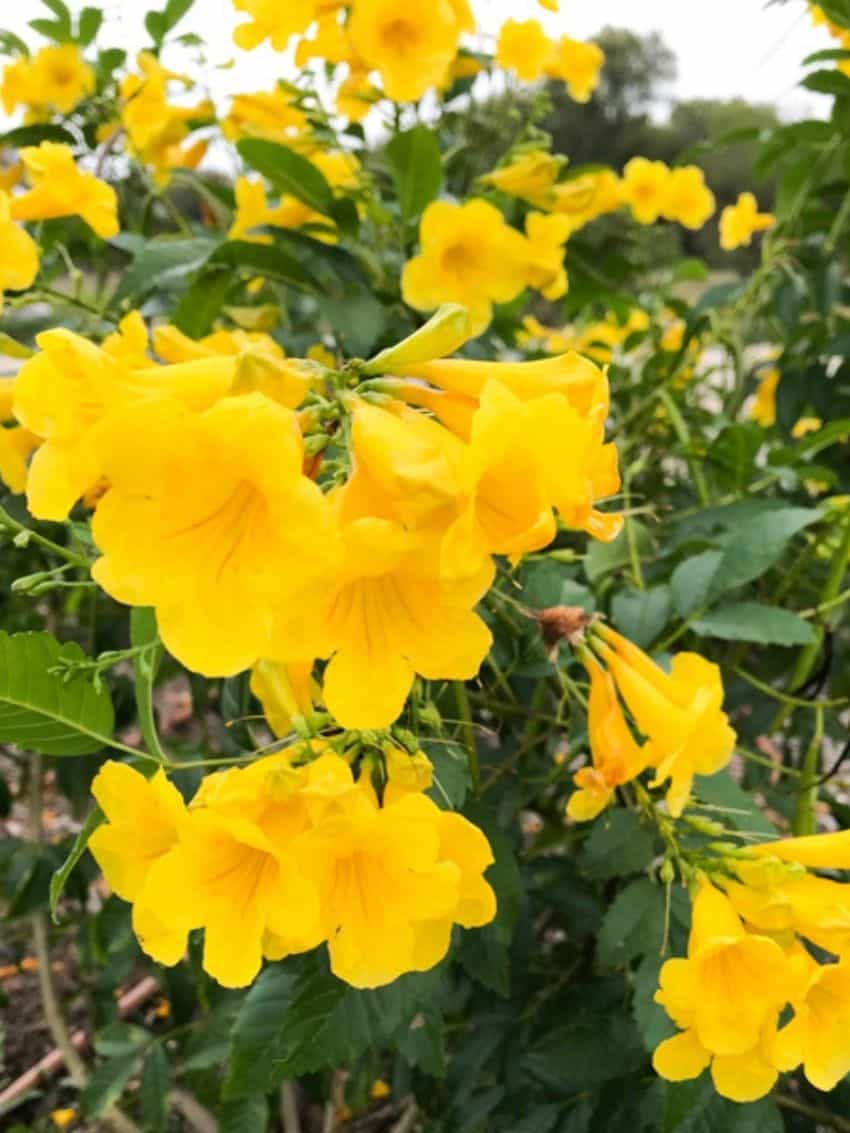
12. Texas Lantana (Lantana urticoides)
There are lots of Lantana varieties available at the nursery, but the only one you want to buy is the native Texas Lantana. Make sure to buy it by its scientific name Lantana urticoides.
Several of the other varieties including Tropical Lantana (Lantana camara) and Purple Trailing Lantana (Lantana montevidensis) are known to be invasive in Texas. Don’t buy these! They spread into natural areas when birds deposit their berries.

However, native Texas Lantana is a beautiful alternative that has been growing in the wild naturally here for thousands of years. It is drought tolerant, a long time bloomer, and a good pollinator plant.
13. Texas Mountain Laurel (Sophora secundiflora)
The purple flowers of the Texas Mountain Laurel are hard to miss in March and April. While this is really a small ornamental tree, it can be grown as a large evergreen shrub. These multi-trunked plants are known to be slow growers and thrive in rocky, poor soil.
You can create a privacy screen by growing several of them close together.
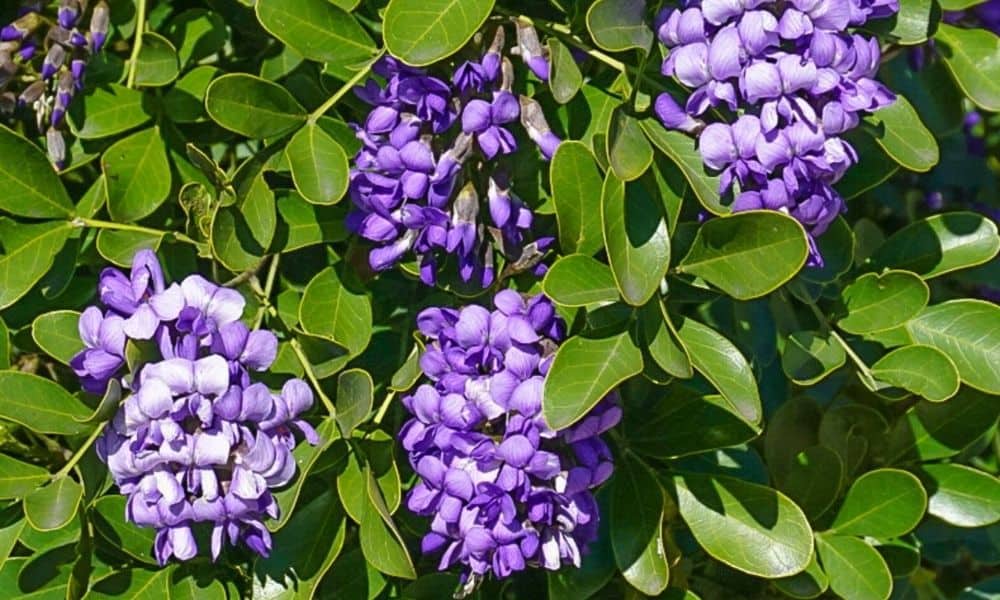
14. Autumn Sage (Salvia greggii)
Autumn Sage is a great option to incorporate into a flower bed. It thrives in full sun but can handle partial sun or afternoon shade. These relatively small shrubs can have red, pink or white flowers. .
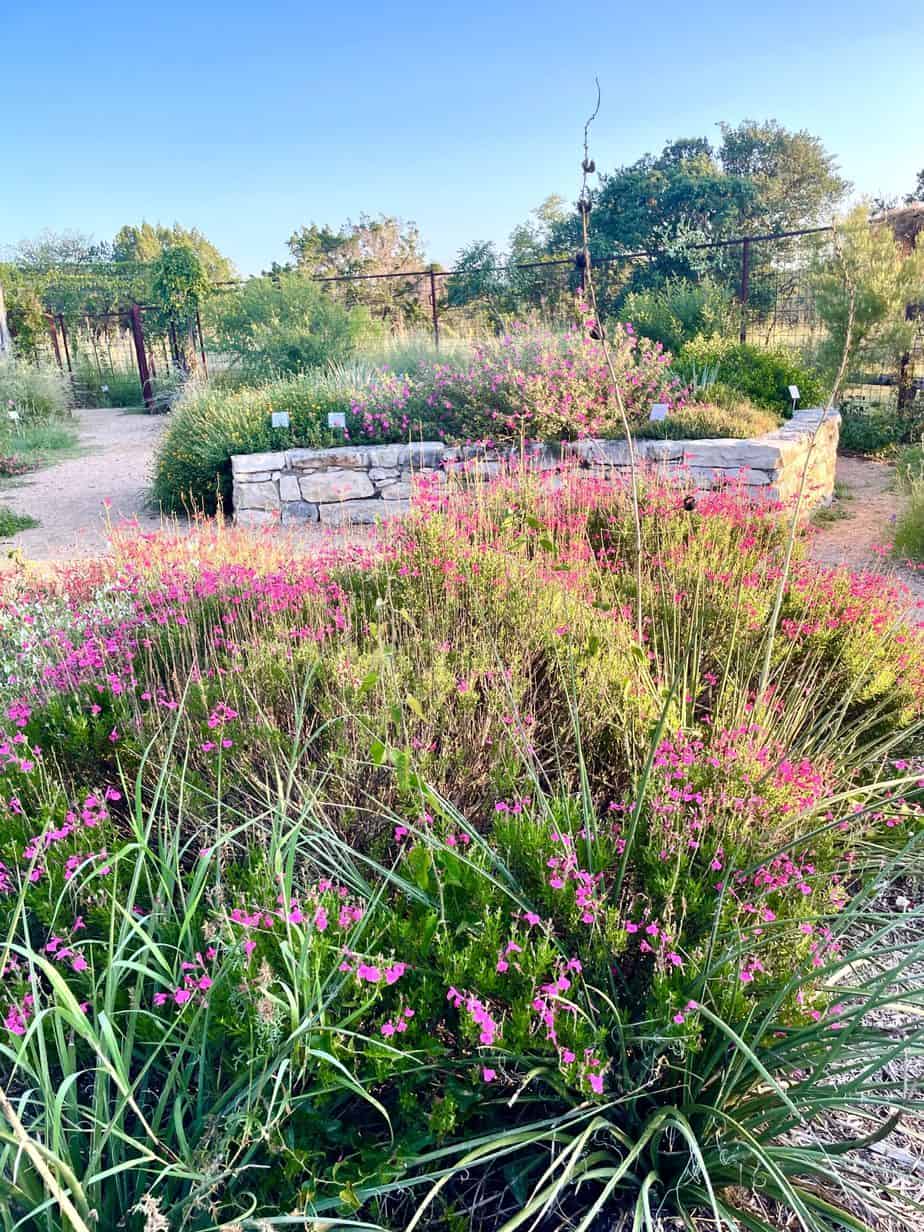
15. Chili Pequin (Capsicum annuum)
Add more pops of color to partial shade areas with the bright tiny red peppers of the Chili Pequin (Capsicum annuum).
This smaller shrub not only looks beautiful, but it can provide you with some yummy (super hot!) peppers to make salsa! Birds love them too.
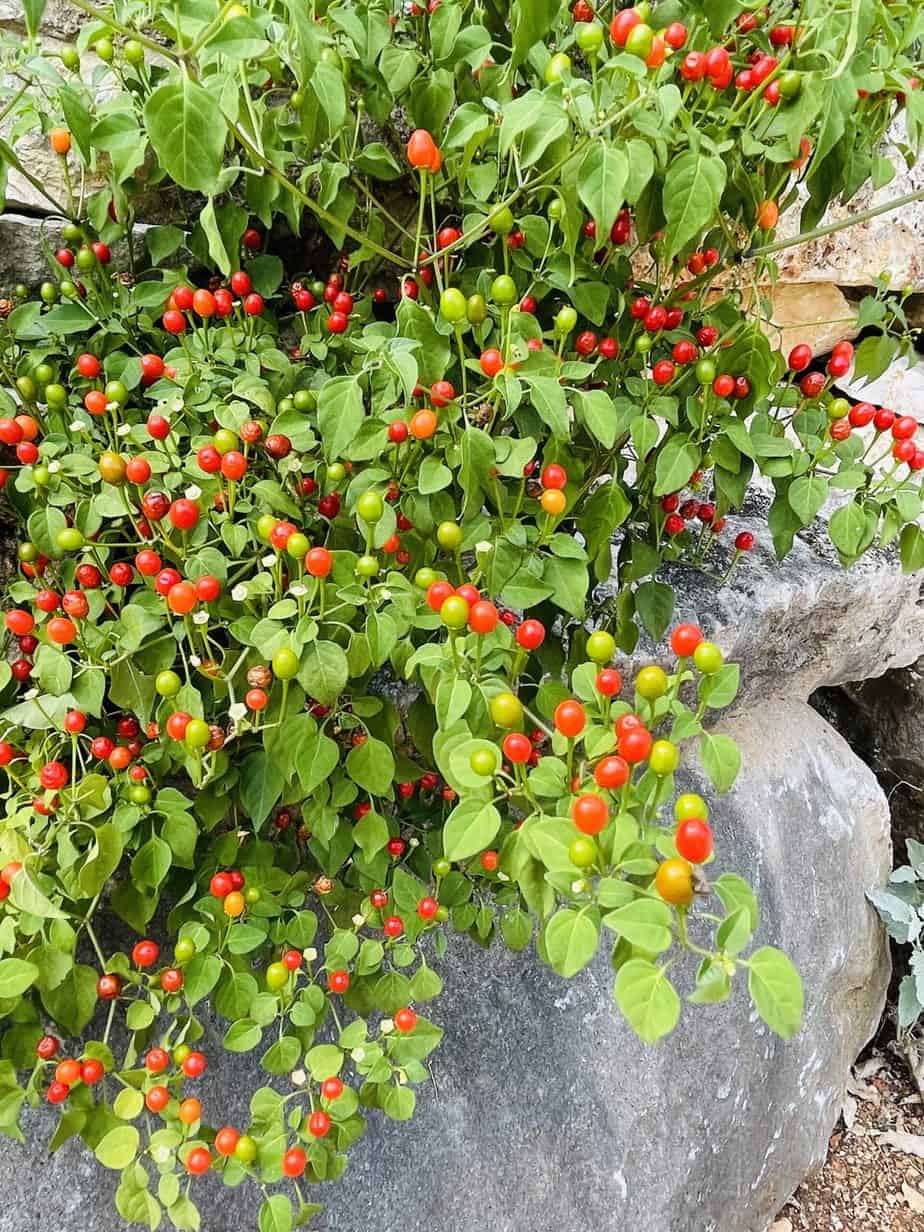
Download the Free PDF: 10 Native Texas Shrubs
I created a handy one-page PDF for you to print and take with you to the plant nursery. It includes a thumbnail photo of each plant along with its common and scientific names, size, sun needs and more! Get it here:
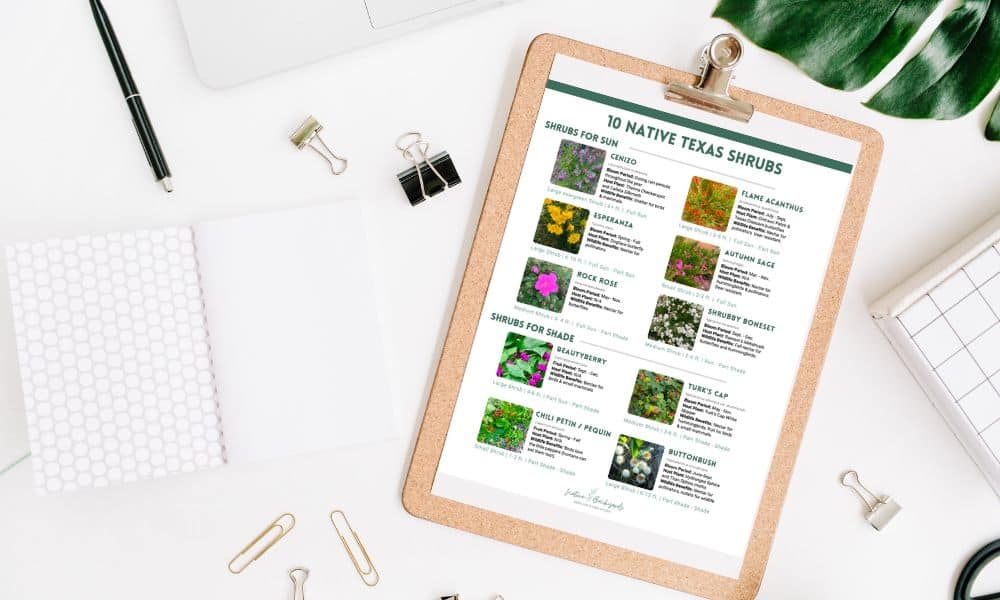
Best Shrubs for North Texas
Texas is a big state with lots of different ecoregions. While many of the shrubs in the list above work well across the state, below are some more customized lists for each major region including some other ideas for shrubs and small trees to incorporate into your landscaping:
Live in the Dallas area? Try one of these options in your yard:
- Agarita (Mahonia trifoliolata)
- American Beautyberry (Callicarpa americana)
- Autumn Sage (Salvia greggii)
- Black Dalea (Dalea frutescens)
- Buttonbush (Cephalanthus occidentalis)
- Cenizo (Leucophyllum frutescens)
- Elbowbush (Forestiera pubescens)
- Evergreen Sumac (Rhus virens)
- Flame Acanthus (Anisacanthus quadrifidus var. wrightii)
- Rock Rose (Pavonia lasiopetala)
- Texas Kidneywood (Eysenhardtia texana)
- Texas Mountain Laurel (Sophora secundiflora)
Best Shrubs for Central Texas
Live in the Austin area? Try one of these options in your yard:
- Agarita (Mahonia trifoliata)
- American Beautyberry (Callicarpa americana)
- Autumn Sage (Salvia greggii)
- Cenizo (Leucophyllum frutescens)
- Chile Pequin (Capsicum annuum)
- Esperanza (Tecoma stans)
- Evergreen Sumac (Rhus virens)
- Flame Acanthus (Anisacanthus quadrifidus var. wrightii)
- Possumhaw Holly (Ilex decidua)
- Red Yucca (Hesperaloe parviflora)
- Texas Lantana (Lantana urticoides)
- Texas Mountain Laurel (Sophora secundiflora)
Best Shrubs for Houston / East Texas
Live in the Houston area? Try one of these options in your yard:
- American Beautyberry (Callicarpa americana)
- Barbados Cherry (Malpighia glabra)
- Buttonbush (Cephalanthus occidentalis)
- Chile Pequin (Capsicum annuum)
- Coralbean (Erythrina herbacea)
- Dwarf Palmetto (Sabal minor)
- False Indigo (Amorpha fruticosa)
- Farkleberry (Vaccinium arboreum)
- Possumhaw Holly (Ilex decidua)
- Strawberry Bush (Euonymus americanus)
- Yaupon Holly (Ilex vomitoria)
Best Shrubs for South Texas
Live in the Corpus Christi area? Try one of these options in your yard:
- Agarita (Mahonia trifoliolata)
- American Beautyberry (Callicarpa americana)
- Barbados Cherry (Malpighia glabra)
- Cenizo (Leucophyllum frutescens)
- Coralbean (Erythrina herbacea)
- Elbowbush (Forestiera angustifolia)
- Flame Acanthus (Anisacanthus quadrifidus var. wrightii)
- Retama (Parkinsonia aculeata)
- Spanish Dagger (Yucca treculeana)
- Texas Lantana (Lantana urticoides)
- Texas Mountain Laurel (Sophora secundiflora)
- Turk’s Cap (Malvaviscus arboreus var. drummondii)
Best Texas Shrubs for Birds
Are you a backyard birder that wants to attract all the songbirds to your yard? These shrubs will be your best bet for providing food and habitat for birds:
- Agarita (Mahonia trifoliata)
- American Beautyberry (Callicarpa americana)
- Buttonbush (Cephalanthus occidentalis)
- Chili Pequin (Capsicum annuum)
- Possumhaw Holly (Ilex decidua)
- Texas Persimmon (Diospyros texana)
- Yaupon Holly (Ilex vomitoria)
Best Texas Shrubs for Pollinators
Want to attract butterflies and bees to your yard? These shrubs are awesome nectar plants:
- Agarita (Mahonia trifoliata)
- Buttonbush (Cephalanthus occidentalis)
- Flame Acanthus (Anisacanthus quadrifidus var. wrightii)
- Fragrant Mistflower (Ageratina havanensis)
- Rock Rose (Pavonia lasiopetala)
- Autumn Sage (Salvia greggi)
- Texas Lantana (Lantana urticoides)
- Turk’s Cap (Malvaviscus arboreus var. drummondii)
Pin this to help spread the word about Texas shrubs!
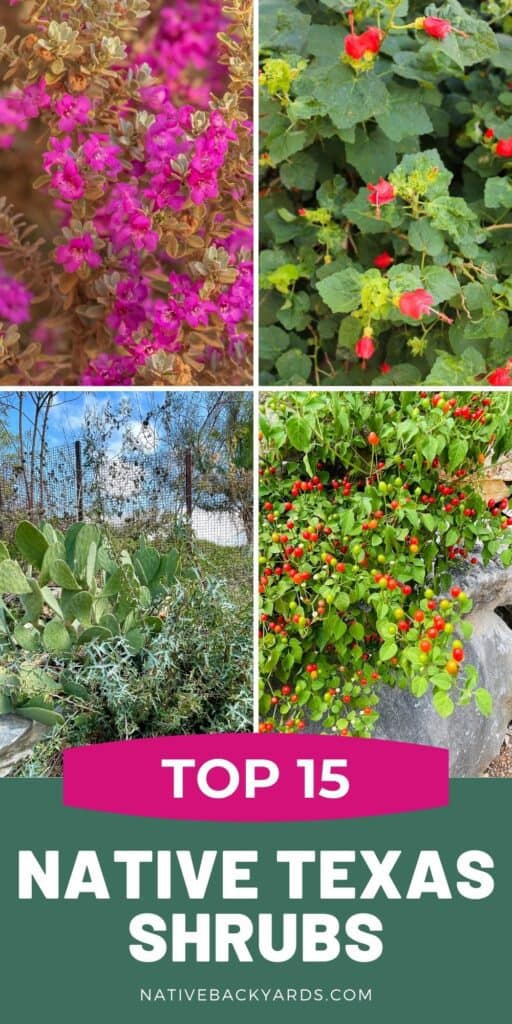
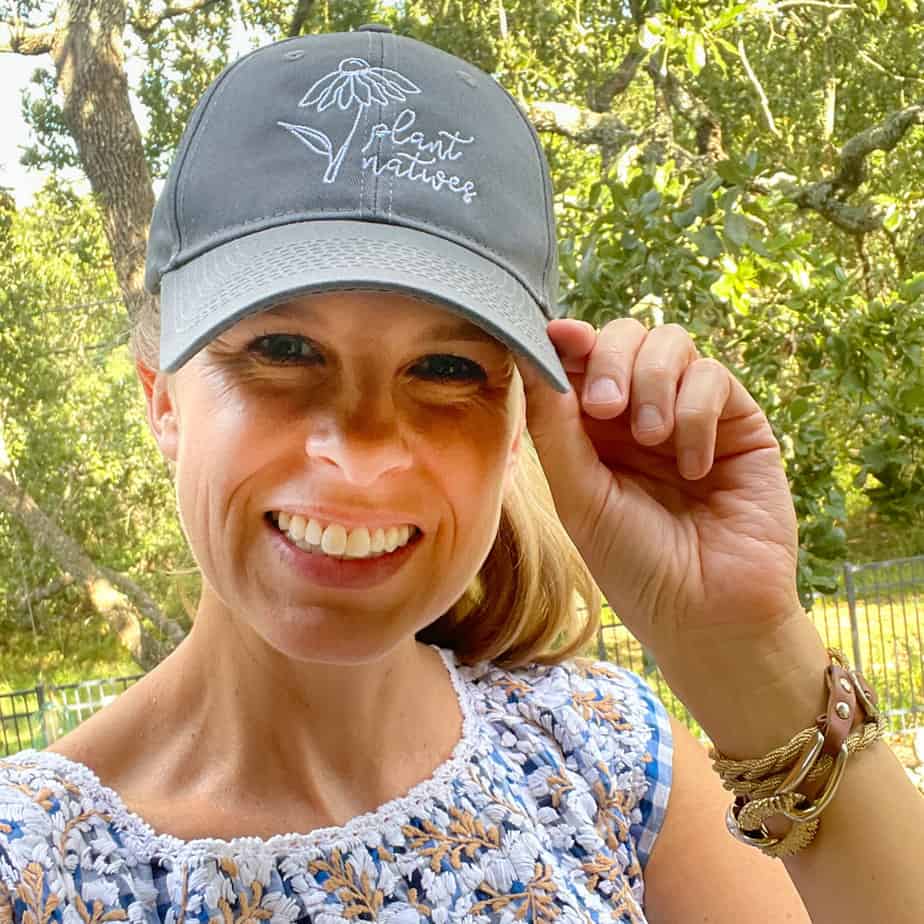
Welcome to Native Backyards! I’m Haeley from San Antonio, Texas, and I want to help you grow more native plants.
I have seen firsthand how the right plants can bring your yard to life with butterflies, bees, and birds. I’ve transformed my yard with Texas natives and I’m excited to share what I’ve learned with you.
Join my newsletter here! – each week I’ll send you helpful tips to make your native plant garden a reality!
Want to learn more about me and my garden? Check out my About page!

Where are the recommendations for West Texas? It’s very challenging out here!!
Great question! I am not super familiar with West Texas shrubs, but check out the list of shrubs for the Big Bend area in this helpful PDF from the Native Plant Society of Texas: https://npsot.org/plant_lists/BigBendList.pdf
We have holly hedges next to our house as well as some boxwoods. what would you recommend up close to a house? or is the holly ok?
I often see Dwarf Yaupon Holly used as a foundation plant. I think it is fine to use! Another evergreen option would be Cenizo / Texas Sage, which can be shaped as a hedge if you want to, but I prefer the more natural look. However, that needs full sun.
we are between Jacksboro and Graham and because of the extremely hot/extreme cold we have had to replant all shrubs for the past 5 years. I am so tired of starting over. just about ready to concrete it all it. nothing lol v a through the extreme heat and then if I replant in the fall it does because of the prolonged freezes we have been having.
I’m sorry to hear that Sue! When you add any new shrubs make sure to water them deeply every week for the first 1-2 months and then taper off to less frequently so they can develop deeper root systems and hopefully handle the extremes. In addition to this list of shrubs, here is a list of Texas native plants that thrive in your area (North Central Texas), created by the Texas Native Plant Society: https://npsot.org/plant_lists/NorthCentralList.pdf
Hi Haeley, thank you for your plant lists – they’re so helpful. I’m surprised to learn that trailing lantana is invasive; have been growing it for years and never seen any seeds on mine. But here in my garden (half way between Austin and Houston), Barbados cherry certainly seemed to be. Their seeds must have a 100% percent germination rate…. I was digging seedlings up for years after digging out the parent plant. Really scary!
So very helpful! I’m brand new to this approach and very much appreciating all this great info.
One question: this past winter here in SATX, we had deer (apparently) pulling off pieces of a boxwood shrub and leaving them on the ground. I’m guessing now that they were hungry and this was something that looked easy to get. Evidently, it didn’t taste good?
So if we’re all planting deer-resistant plants and shrubs, what do the local deer eat?? If all the other wildlife is needing natives plants to eat, doesn’t that also apply to deer? If so, we can find plants that they can eat, too? (Obviously, not so attractive in the landscaping!) What to do?
Hi Suzi, Thanks for your note! Deer will eat just about anything – including “deer resistant” plants – when they are really hungry or you have a very large deer presence in your area. Given that deer aren’t picky, any native plant not listed as deer resistant, is probably something they would like to eat if you are looking to feed the deer! However, if your goal is to have some blooms remain for pollinators, it is helpful to add some deer resistant plants to your garden as well. Here is a list of deer resistant Texas native plants: https://nativebackyards.com/texas-deer-resistant-plants/
Suzi, thanks for all the great articles on growing native…but I am having a very difficult time finding reliable sources for plants or seeds. Do you have any? Looking for shrubs and ground cover. Thanks
Nancy, where are you located? I may be able to direct you to a native plant nursery nearby. For seeds, I recommend Native American Seed.